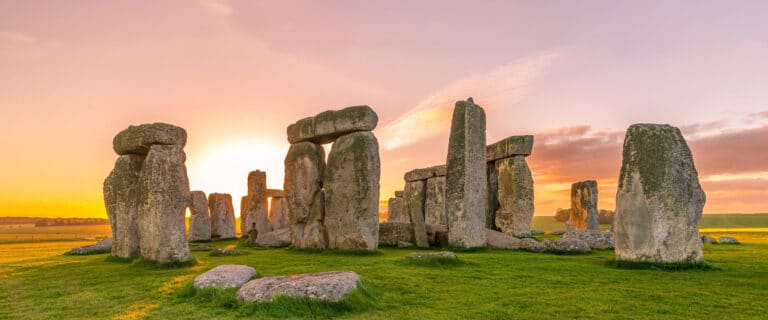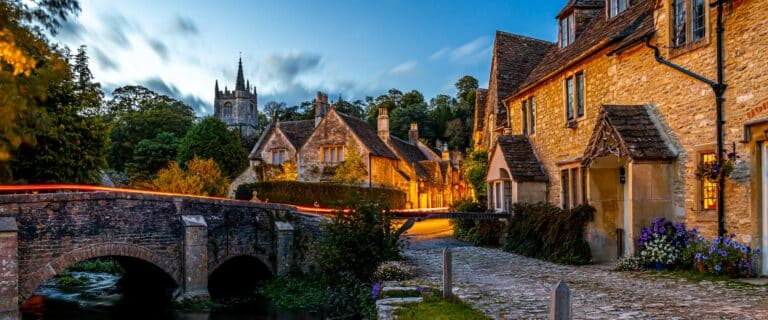An England vacation that includes estate and castle gardens is heaven for those who want to experience beauty. The first great English parks were created for private homes in the 17th century. They featured vast lawns, small forests and glens, and classical architecture. At the center of this landscape was a grand estate or castle. Designers imitated the then-new Gardens of Versailles for the area behind the home. They were symmetrical to a fault, sometimes including a box-hedge maze. In short, these parks were meant to be breathtaking. They are.

Share this Graphic On Your Site
By the 18th century formal was out-of-fashion, and an idealized version of nature came into vogue. The wealthy and titled wanted to walk out their door into the Garden of Eden. The English, still copying French sensibilities, designed gardens that mimicked French landscape paintings. Gardens usually included a water feature such as a lake, rambling lawns, plus decorative and exotic plants. Faux temples were built along with a smattering of outcroppings meant to resemble ancient ruins.
Public parks came into being in the 19th century so common people could enjoy this stylized form of nature. (Gardens still tended to be largest around the gentry’s country estates.) There are hundreds of gardens that have been loved over the centuries, and many more taken over by weeds. Here are seven favorites, by county.
London County
The capital of England has a slew of lovely historic homes and gardens. The Garden at Buckingham Palace is a private park attached to the Royals’ home. It’s in the city of Westminster, is 42 acres, and has 2 ½ miles of paths. It takes ten gardeners to keep it looking just-so. The tree varieties include Indian chestnut, plane, silver maple, and a swamp cypress. There is still one, lone mulberry tree planted by James I. He tried, without success, to breed silkworms in a mulberry forest.Yorkshire County
There are a surprising number of exceptional gardens open to the public in Yorkshire. Styles run the gamut from cottage, to formal, to homey and relaxed. A particularly exceptional park is the Helmsley Walled Garden. Built in 1759, it is five lovely acres in the sheltering ruins of Helmsley Castle. It was a bounty of fruit, vegetables, and flowers for the residents until 1920. The garden fell into disrepair, and loving restoration began in 1994. When you visit, enjoy the glasshouse, herb gardens, a vegetable patch, kitchen garden, and 100 varieties of clematis. The garden is also used for emotional healing. Sit beneath Victorian vines at the café for tea.The Cotswolds
People fall in love with the Cotswolds’ villages and historic houses, crafted from local stones and surrounded by gardens. Prince Charles’ home, Highgrove House, is in the Cotswolds, and he has lovingly restored gardens that hadn’t been tended for decades. One of the most extraordinary gardens is at Abbey House, once a Benedictine Monastery and founded in 666 AD. First cultivated by monks for medicinal herbs, it became private property after Henry VIII banned the Catholic presence in England. Today, see thousands of tulips, daffodils, and roses. The circular herb garden, which would have pleased the early monks, has 2,000 different herbs. Walk a path along the river, and plan to spend a beautiful afternoon.Gloucestershire County
Bordering on South Wales, this entire county is a garden-lovers’ paradise. (The last of Henry VIII’s six wives is buried here at Sudeley Castle.) Hidcote Manor Garden is considered one of the top-ten gardens in England and is a must-see. Influenced by the Arts and Crafts Movement, horticulturalist Lawrence Johnston made Hidcote his life’s work. He employed ten full-time gardeners and created a series of small gardens within a large one. It’s famous for rare shrubs and trees, water features, and areas of wild flowers. Sit by one of the pools, and you’ll notice the scent of old roses.Cornwall County
This county may have more gardens than any other. If you’re visiting the area around Penzance or Truro, treat yourselves to Caerhays Castle Gardens. This is one of the finest places to see rhododendrons, magnolias, and camellias. And, the castle is open! Caerhays is in a sheltered valley that overlooks Porthluney Cove on the South Cornish Coast. (Stop and look out over the wild Atlantic.) It is 140 acres, and you’re invited to explore. Pay attention to rare woodland trees and shrubs that came from China. There are plenty of paths, so give yourself time to relax and enjoy.Devon County
Devon is romantic and dramatic. There are two stunning coastlines—the north is wild, and the south is gentle. Both have terrific beaches. Clovelly Court Gardens is a classic. It’s a restored Victorian walled kitchen garden. There are peaches, nectarines, apricots, vineyards, citrus fruit, figs, cucumbers, peppers, chiles, eggplant, and tomatoes. You can buy these, in season, as well as flowers and potted plants. The vegetables are organically grown, and the crops are rotated. Sitting on the Bristol Channel, Clovelly Court’s position is ideal for the growth of tender and exotic plants.Sussex County
Sussex is one of the sunniest places in England. There are soft, rolling hills, villages that are secret gems, and a beautiful coastline. It’s only 45 minutes from London by car, so it’s an easy excursion from the city. Arundel Castle has been open to visitors since 1800. The walled gardens are an inspiration and include a cool herbaceous border with contrasting foliage. (There’s also an organic garden.) A rare peach house has been restored, and exotic fruits and vegetables grow within. Sensitive perennials, such as bananas and palms, remain in the ground all year around. Visit the medieval bowling green, now planted with roses, and you’ll feel as if you just stepped off a page from Alice in Wonderland.Castles, grand estates, and soft rolling hills… Natural gardens that run riot in English villages, and manicured gardens in Georgian yards. There is no place like England for experiencing National Parks and Gardens. It is as much a part of the culture as tea, Shakespeare, and the Royal Family.
If you want to get into the sweet side of England, ask your Destination Expert about including a few extraordinary English gardens in your itinerary!









